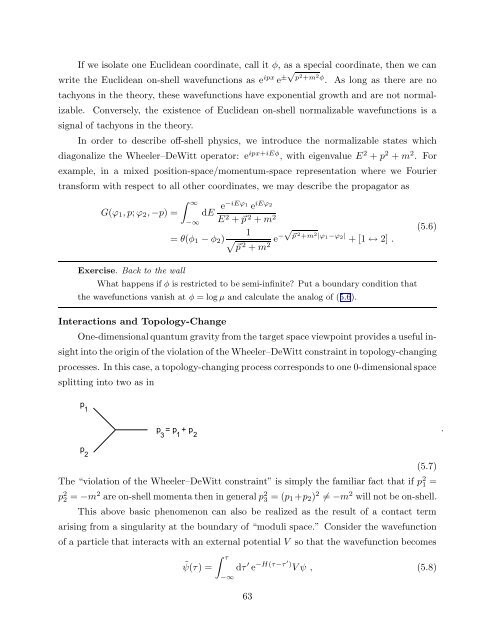arXiv:hep-th/9304011 v1 Apr 5 1993
arXiv:hep-th/9304011 v1 Apr 5 1993
arXiv:hep-th/9304011 v1 Apr 5 1993
Create successful ePaper yourself
Turn your PDF publications into a flip-book with our unique Google optimized e-Paper software.
If we isolate one Euclidean coordinate, call it φ, as a special coordinate, <strong>th</strong>en we can<br />
√p<br />
write <strong>th</strong>e Euclidean on-shell wavefunctions as e ipx e ± 2 +m 2φ . As long as <strong>th</strong>ere are no<br />
tachyons in <strong>th</strong>e <strong>th</strong>eory, <strong>th</strong>ese wavefunctions have exponential grow<strong>th</strong> and are not normalizable.<br />
Conversely, <strong>th</strong>e existence of Euclidean on-shell normalizable wavefunctions is a<br />
signal of tachyons in <strong>th</strong>e <strong>th</strong>eory.<br />
In order to describe off-shell physics, we introduce <strong>th</strong>e normalizable states which<br />
diagonalize <strong>th</strong>e Wheeler–DeWitt operator: e ipx+iEφ , wi<strong>th</strong> eigenvalue E 2 + p 2 + m 2 . For<br />
example, in a mixed position-space/momentum-space representation where we Fourier<br />
transform wi<strong>th</strong> respect to all o<strong>th</strong>er coordinates, we may describe <strong>th</strong>e propagator as<br />
∫ ∞<br />
G(ϕ 1 , p; ϕ 2 , −p) = dE e−iEϕ 1<br />
e iEϕ 2<br />
−∞ E 2 + ⃗p 2 + m 2<br />
1<br />
√⃗p<br />
= θ(φ 1 − φ 2 ) √<br />
⃗p 2 + m 2 e− 2 +m 2 |ϕ 1 −ϕ 2 | + [1 ↔ 2] .<br />
(5.6)<br />
Exercise. Back to <strong>th</strong>e wall<br />
What happens if φ is restricted to be semi-infinite? Put a boundary condition <strong>th</strong>at<br />
<strong>th</strong>e wavefunctions vanish at φ = log µ and calculate <strong>th</strong>e analog of (5.6).<br />
Interactions and Topology-Change<br />
One-dimensional quantum gravity from <strong>th</strong>e target space viewpoint provides a useful insight<br />
into <strong>th</strong>e origin of <strong>th</strong>e violation of <strong>th</strong>e Wheeler–DeWitt constraint in topology-changing<br />
processes. In <strong>th</strong>is case, a topology-changing process corresponds to one 0-dimensional space<br />
splitting into two as in<br />
p 1<br />
.<br />
p<br />
2<br />
p = p + p<br />
3 1 2<br />
(5.7)<br />
The “violation of <strong>th</strong>e Wheeler–DeWitt constraint” is simply <strong>th</strong>e familiar fact <strong>th</strong>at if p 2 1 =<br />
p 2 2 = −m 2 are on-shell momenta <strong>th</strong>en in general p 2 3 = (p 1 +p 2 ) 2 ≠ −m 2 will not be on-shell.<br />
This above basic phenomenon can also be realized as <strong>th</strong>e result of a contact term<br />
arising from a singularity at <strong>th</strong>e boundary of “moduli space.” Consider <strong>th</strong>e wavefunction<br />
of a particle <strong>th</strong>at interacts wi<strong>th</strong> an external potential V so <strong>th</strong>at <strong>th</strong>e wavefunction becomes<br />
˜ψ(τ) =<br />
∫ τ<br />
−∞<br />
dτ ′ e −H(τ−τ ′) V ψ , (5.8)<br />
63
















